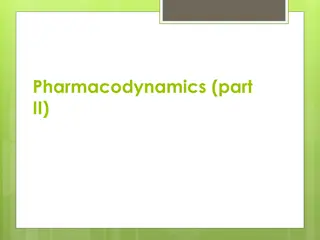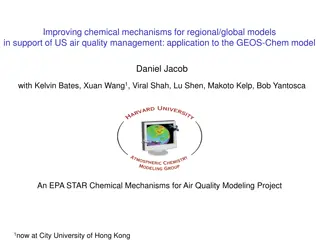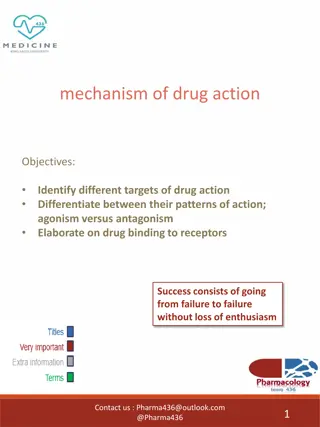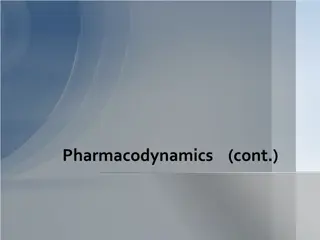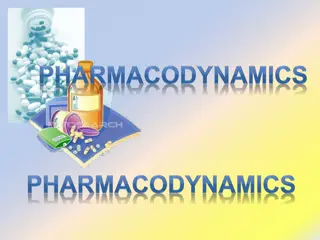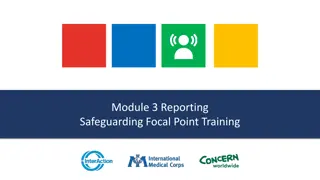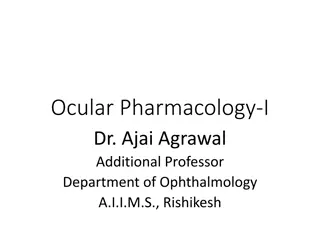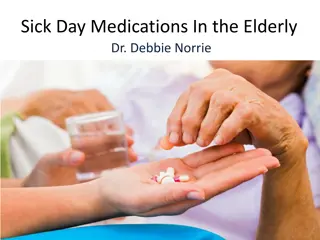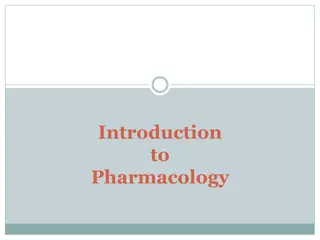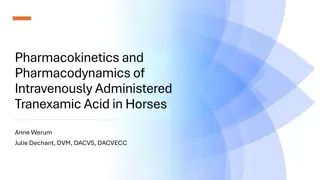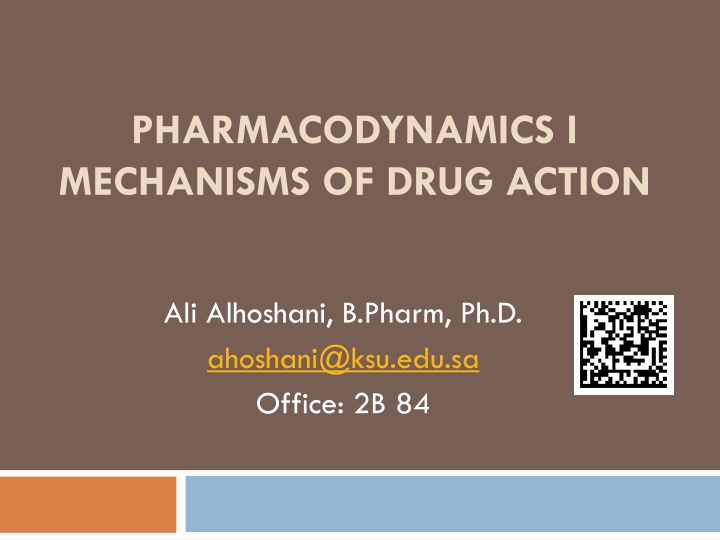
Pharmacodynamics and Drug Mechanisms of Action
Explore the principles behind pharmacodynamics, including the targets of drug action, the difference between agonism and antagonism, and the role of drug-receptor binding in this branch of pharmacology. Discover the various mechanisms by which drugs produce their effects, such as through receptor-mediated interactions and physiochemical properties. Learn about different targets for drug binding, including ion channels and carrier molecules, and their influence on physiological processes.
Download Presentation

Please find below an Image/Link to download the presentation.
The content on the website is provided AS IS for your information and personal use only. It may not be sold, licensed, or shared on other websites without obtaining consent from the author. If you encounter any issues during the download, it is possible that the publisher has removed the file from their server.
You are allowed to download the files provided on this website for personal or commercial use, subject to the condition that they are used lawfully. All files are the property of their respective owners.
The content on the website is provided AS IS for your information and personal use only. It may not be sold, licensed, or shared on other websites without obtaining consent from the author.
E N D
Presentation Transcript
PHARMACODYNAMICS I MECHANISMS OF DRUG ACTION Ali Alhoshani, B.Pharm, Ph.D. ahoshani@ksu.edu.sa Office: 2B 84
Mechanisms of Drug action By the end of this lecture, you should: Identify different targets of drug action Differentiate between their patterns of action; agonism versus antagonism Elaborate on drug binding to receptors
What is Pharmacodynamics? Pharmacodynamics is a branch of pharmacology that deals with the study of the biochemical and physiological effects of drugs and their mechanisms of action.
What are the mechanisms of drug action? Drugs can produce their actions by: Binding with biomolecules (Receptor-mediated mechanisms): Biomolecules = Targets=Receptors Mostly protein in nature (protein target). Non receptor-mediated mechanisms Physiochemical properties of drugs. 1) 2)
What are the mechanisms of drug action? Drugs can produce their actions by: Binding with biomolecules (Receptor-mediated mechanisms): Protein targets for drug binding Physiological receptors Enzymes Ion channels Carriers Structural protein
What are targets for drug binding ? Ion channels e.g. Sulfonylurea drugs (antidiabetic drugs): block K+ outflux via the K channels in pancreatic beta cells resulting in opening of calcium channels and insulin secretion.
What are targets for drug binding ? Ion channels e.g. Sulfonylurea drugs (antidiabetic drugs):
What are targets for drug binding ? Carrier molecules The drug binds to such molecules altering their transport ability Responsible for transport of ions and small organic molecules between intracellular compartments, through cell membranes or in extracellular fluids. e.g., Na+,K+-ATPase inhibitor
What are targets for drug binding ? Carrier molecules Digoxin: blocks Na efflux via Na pump; used in treatment of heart failure. Digoxin
What are targets for drug binding ? Carrier molecules Cocaine: blocks transport or reuptake of catecholamines (dopamine) at synaptic cleft The dopamine transporter can no longer perform its reuptake function, and thus dopamine accumulates in the synaptic cleft.
What are targets for drug binding ? Carrier molecules Effect of cocaine
What are targets for drug binding ? Structural proteins e.g. tubulin is target for: Vincristine anticancer agent Colchicine used in treatment of gout Tubulin Structure
Drug-Receptor Interaction Binding Forces between drugs and receptors Ionic bond. Van-Dar-Waal. Hydrogen bond. Covalent bond.
Drug-Receptor Interaction Affinity Ability of a drug to combine with the receptor. D + R D-R complex Effect. Efficacy (Intrinsic Activity) Capacity of a drug receptor complex (D-R) to produce an action. is the maximal response produced by a drug (E max).
Drug-Receptor Interaction Agonist is a drug that combines with receptor and elicit a response (has affinity and efficacy). Antagonist is a drug that combines with a receptor without producing responses. It blocks the action of the agonist (has affinity but no or zero efficacy). e.g. atropine
Drug-Receptor Interaction Agonist and Antagonist
Drug-Receptor Interaction Agonist Full agonist. Partial agonist Full Agonist A drug that combines with its specific receptor to produce maximal effect by increasing its concentration (affinity & high efficacy). e.g. acetylcholine (Ach).
Drug-Receptor Interaction Agonist Partial Agonist combines with its receptor & evokes a response as a full agonist but produces submaximal effect regardless of concentration (affinity & partial efficacy). e.g. pindolol A beta blocker which is a partial agonist, produces less decrease in heart rate than pure antagonists such as propranolol.


